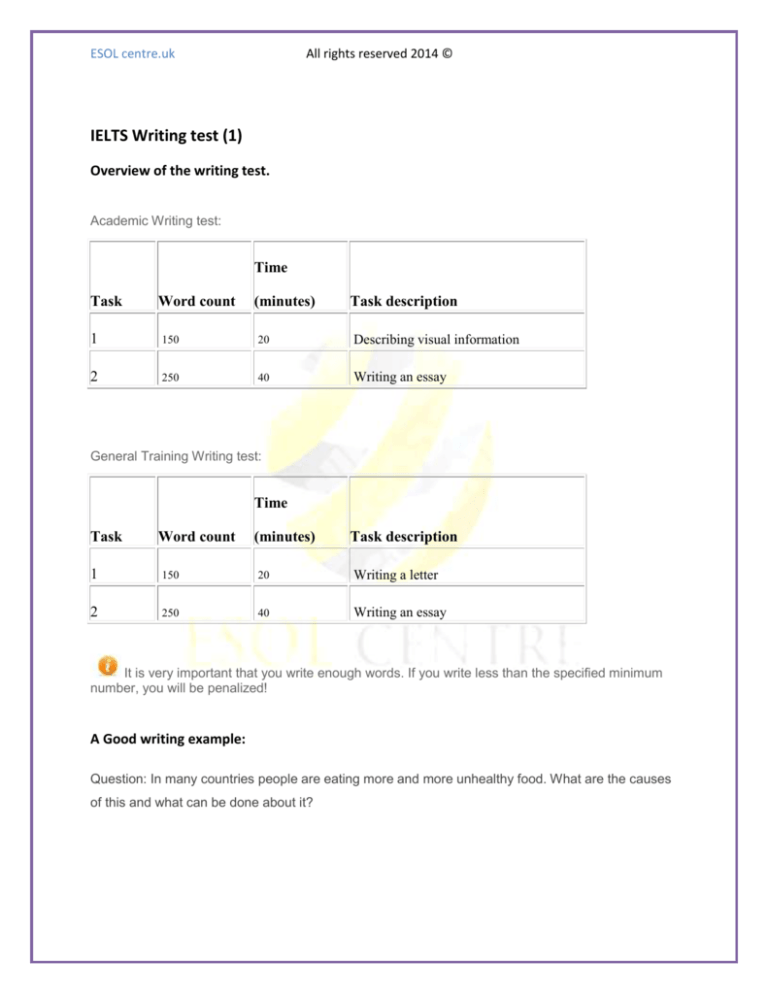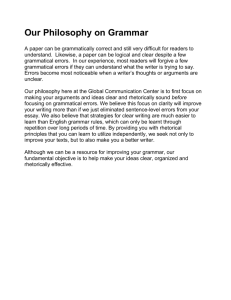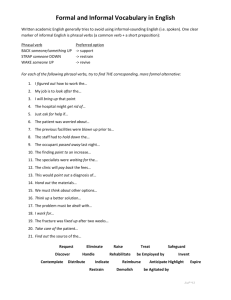
ESOL centre.uk
All rights reserved 2014 ©
IELTS Writing test (1)
Overview of the writing test.
Academic Writing test:
Time
Task
Word count
(minutes)
Task description
1
150
20
Describing visual information
2
250
40
Writing an essay
General Training Writing test:
Time
Task
Word count
(minutes)
Task description
1
150
20
Writing a letter
2
250
40
Writing an essay
It is very important that you write enough words. If you write less than the specified minimum
number, you will be penalized!
A Good writing example:
Question: In many countries people are eating more and more unhealthy food. What are the causes
of this and what can be done about it?
ESOL centre.uk
All rights reserved 2014 ©
Answer:
One of the reasons why the number of people eating food that is less nutritious is increasing is that
there is so much fast food available nowadays. Another factor is that this type of food is often very
affordable and, as a result of price and availability, more and more of it is consumed.
One possible solution could be to increase the amount of education about food and health given in
schools. This would help people to make more informed choices about what they eat, both as
children and as adults.
Comment: The example is good because it answers the question and the ideas are well organised
and in a logical order.
There is a good range of structures and relevant vocabulary and it is also grammatically accurate.
Assessment criteria
In the IELTS Writing test, candidates are assessed in four areas:
Task response / achievement
Coherence and cohesion
Lexical resource
Grammatical range and accuracy
Task response / achievement
This is the way the writer responds to a question or achieves a task. You would score highly if you
answer the question (describing possible causes and giving a solution) and give the information
needed.
It is very important to give full answers in the IELTS Writing test. If your essay is not long enough or
does not address all the points you will lose marks. Task response is the name for this criterion in
Task 1 in the Writing test. It is called Task achievement in Task 2.
ESOL centre.uk
All rights reserved 2014 ©
Coherence and cohesion
If a text has good coherence it is well-organised and clear. Cohesion involves linking ideas
together within a paragraph or text. One way to improve cohesion is to use linking words or phrases
such as On the other hand to connect ideas and sentences, the uses of synonyms and paraphrasing
are also important skills.
Lexical resource
This is the ability to use vocabulary accurately and appropriately in different situations. This makes
what the writer says more interesting and effective. In the example above, the writer uses interesting
and appropriate words such as nutritious, affordable andinformed choices.
Grammatical range and accuracy
This is the ability to use a range of grammatical structures in simple and complex sentences without
making a mistake. In the example above, the writer uses a range of language, including passives (is
consumed) and relative clauses (that is less nutritious).
The writing is also very accurate, helping the reader to understand the message correctly and
without effort.
These four categories are used to assess candidates’ writing in both the Academic and the General
Training tests.
Task response
Students don’t explain their ideas.
Students find it difficult to write very much.
Coherence and cohesion
Students find it difficult to link sentences.
Student don’t order ideas logically.
Lexical resource
Students have very little vocabulary.
Students have problems with spelling words.
ESOL centre.uk
All rights reserved 2014 ©
Grammatical range and accuracy
Students only use very simple structures.
Students make a lot of grammatical mistakes.
Differences between formal and informal writing
To be an effective writer, it is very important to think about your reader (who is going to read
your work?- assessor, tutor, friend etc.) and the purpose of writing, as this will affect your style
of writing. For instance, if you were writing an email to a friend you would probably write in
an informal style, but if you were writing a business report you would write in a formal style.
In the IELTS Academic Writing test, candidates need to write in an academic style and they may
find this difficult. Academic writing is quite formal, impersonal and objective. The focus is on
the facts or the argument, rather than the personal feelings of the writer.
The style needed in any piece of writing can affect the organisation, choice of lexis and
grammatical structures.
Read the texts below and choose whether each is formal or informal.
This paper examines the British approach to using biometrics for ‘security’ and verification of
identity purposes. It begins by outlining the Government’s roll-out of biometric ID documents,
examines some of the criticisms of the Information Commissioner, and scrutinizes the use of
biometrics in schools. It concludes that technologies for security exacerbate insecurities and
that digi-governance requires a rethink if informed consent, accountability and legal remedies
are to be credible.
Formal
Informal
Most people think that most kids learn to talk by chatting to their mum and dad, mates etc.
But I read somewhere that the chance to do this is getting less now and it turns out that this
makes things hard for them when they’re older. Isn’t that terrible? I think it’s awful.
Formal
Informal
ESOL centre.uk
All rights reserved 2014 ©
Characteristics of formal and informal writing
Words and phrases to be avoided in more formal, academic writing include:
informal words and expressions, such as kids and getting less.
contractions, such as they’re.
abbreviations, such as etc.
informal phrasal verbs, such as turns out.
vague expressions, such as somewhere and things.
overuse of personal pronouns, such as I.
questions to the reader, such as Isn’t that bad?
emotional responses, such as This is awful!
In academic writing, avoid using:
abbreviations, e.g. a.s.a.p.
contractions, e.g. won't
questions to the reader, e.g. Can you believe that?
too many personal pronouns, e.g. I, we
informal phrasal verbs, e.g. come up with
emotional language, e.g. a wonderful result
vague language, e.g. something like that
informal words, e.g. daddy
√ You can now move on to part 2 of this Unit.







